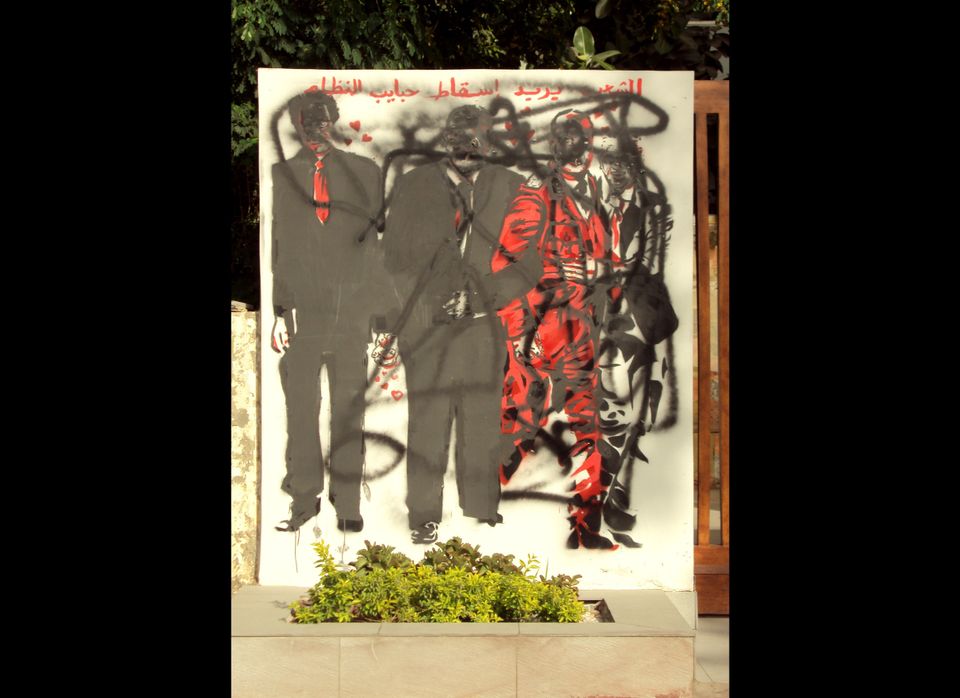Last week, the New York Times ran a story titled, "The Maturing of Street Art in Cairo," that linked a move away from simple political slogans to a healthier creative climate in the still-unstable city.
While it's undoubtedly true that things have changed since the revolution, the delicate situation Cairo's street artists face deserves even more investigation. It is an important moment, and one with implications both for dissent in the region and for street art's power to stay provocative in general.
(Article continues below slideshow.)
A number of obstacles still stand in the way of Cairo street art's "maturity." The first comes from the same decentralized structure that aided activists in ousting President Hosni Mubarak earlier this year. Now that the revolution is over, the battle no longer pits a loose-knit group of saboteurs against a monolithic authority. Today, the reformists must confront an equally amorphous group of pro-Mubarak holdouts. In some areas, these counter-revolutionaries scribble over more liberal pieces faster than new ones can be put up.
Prominent Cairo artist Ganzeer has had at least two major works defaced. One showed Islam Raafat, a young revolutionary who was killed by police; another depicted Mubarak holding hands and linking arms with some members of his inner circle who remained in the government.
And Ganzeer, who was jailed briefly in May for putting up stickers of his Freedom Mask, may even have to distance himself from his most revolutionary work. In June, Egyptian blog Anarchitext asked Ganzeer whether he was responsible for "How to Revolt Cleverly," a widely-distributed instructional pamphlet. The artist tweeted back, initially saying only, "shuuuuuuush." Ganzeer has since denied involvement, but the fact remains that whoever did design the pamphlet doesn't yet feel comfortable enough to admit it.
That artists have greater freedom than they did under Mubarak, is, of course, undeniable. Nowhere is this more apparent than in the encroachment of Western imagery on the pieces. Every human right that was won in Tahrir Square and on Twitter seems to have its representation in the cosmopolitan new works. For critiques of traditional masculinity, one might look to the stencils of Freddy Mercury and Woody Allen; for the globalization of beauty, try the Pop Art portrait of iconic Egyptian singer and actress Asmahan (images via suzeeinthecity.wordpress.com).
But if American symbolism has become a newly de-regulated industry for Egyptian artists, it's not deployed without an element of cynicism. The English-language slogans and Disney characters that pervade the work of Cairo artist Keizer, for example, are targeted largely at the sophisticated upper-class.
In a feature on Keizer, Cairo blogger Suzee In The City offers the following explanation:
This makes sense when you look at his quotes like 'Who's Watching the Watchers' or pieces like the Snow White with the machine gun. These art pieces speak to a segment of Egyptian society that watches Walt Disney and speaks English well enough to appreciate the dichotomy between the cartoon character's cartoon femininity and the brutality of the weapon.
But what of his stencils that simply read, "You Are Beautiful" (in English)? Is it really his intention to remind the leisure class of this? Or does it have something to do with the fact that inspirational messages on crumbling walls are more likely to get blogged about if they're in English?
I don't mean to single out Keizer; he's made much more subtle acts of protest, such as the Girl on a Swing and the ubiquitous Ants. But the difficulties with some of his work are emblematic of the larger challenges facing free expression in a post-Mubarak Egypt.
It's a great time to be a street artist in Cairo, because political stencils are seen as a surefire indicator that things are looking up. And since this is exactly what we pro-revolution journalists abroad want to believe, there's ample room for an artist to profit from our false positives.
Last week, Ganzeer told Daily News Egypt that he prefers not to be called a street artist. "They think of everything in street art terms," he said, "and [react] to everything with street art." If the term has lost some of its humanitarian connotations, it may be because "street art" and "revolutionary art" are no longer synonymous in Egypt.
The very meaning of graffiti has changed in Cairo since the first slogans appeared in back alleys and on tanks. What used to look like ad-hoc expressions of protest have started to look like "Street Art." Shepard Fairey parodies are everywhere. Street art is Keizer's full-time occupation, and he signs every one of his pieces.
